Using the HTTP/2 Network Protocol, you can reach websites faster than ever before. However, you may stumble across an err_http2_protocol_error. This can prevent you from accessing certain web pages.
Fortunately, there are many solutions for the HTTP/2 protocol error. Whether you fix the problem within your browser or operating system, you can easily remove this troublesome message. Then, you can continue with your normal online browsing.
In this post, we’ll introduce you to the err_http2_protocol_error and its causes. Then, we’ll show you how to fix this problem on both a browser and a personal device. Let’s get started!
What Does the err_http2_protocol_error Mean?
When you perform a search, you may receive an “err_http2_protocol_error” message. This can prevent you from accessing a web page, stating that it is currently down or was permanently moved to another address:
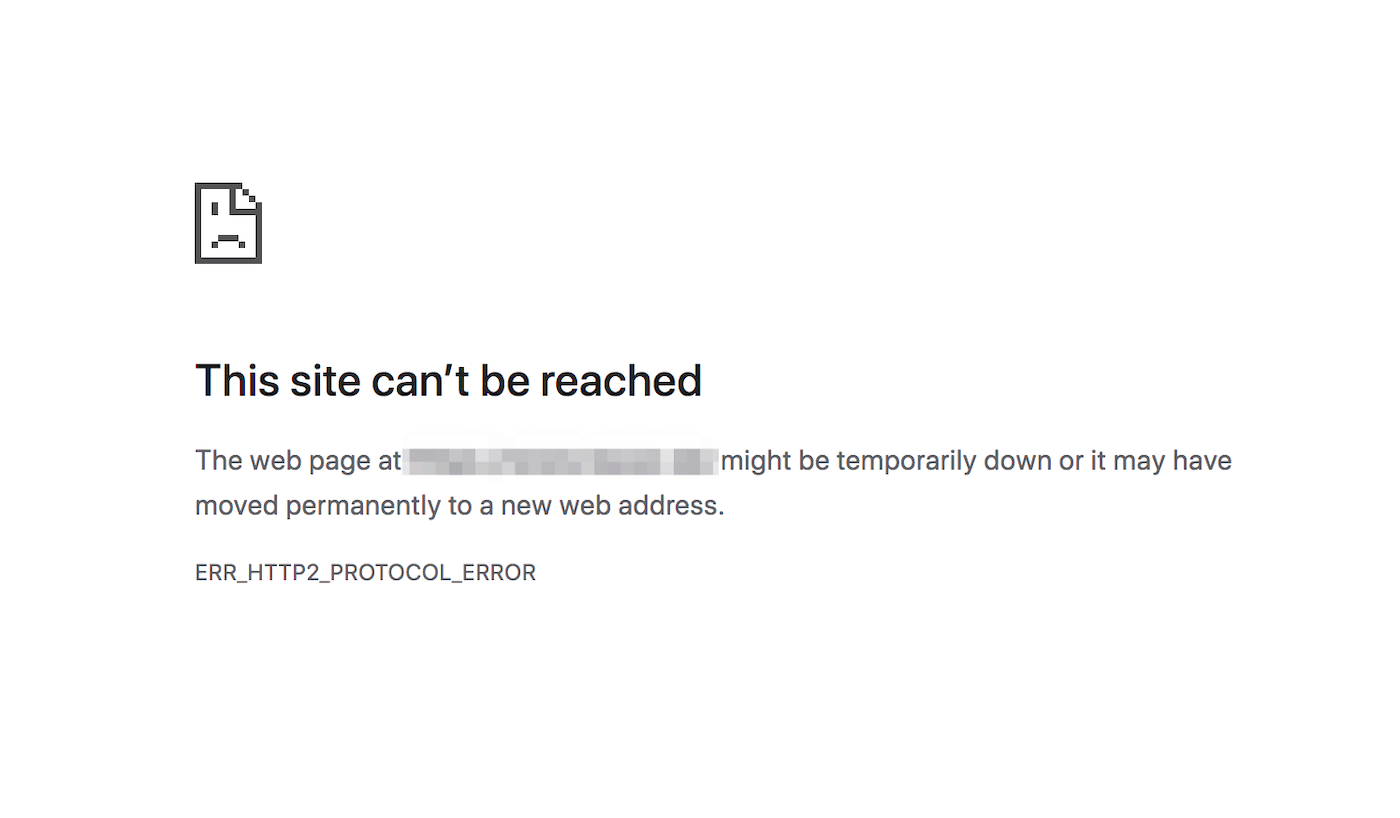
To understand the err_http2_protocol_error, let’s first discuss the Hypertext Transfer Protocol (HTTP). This is the application protocol that allows the retrieval of online resources.
A protocol is a set of rules that controls how data is transferred between clients. In this case, it can govern the HTTP requests between users and web browsers.
Currently, most browsers, applications, and systems run on the HTTP/2 network protocol. This updated protocol comes with enhanced efficiency for virtual data communication.
Although this update has many benefits, you still may experience errors when accessing online content. Sometimes, the err_http2_protocol_error will display as an HTTP error message and prevent you from accessing the online resource you’re looking for.
What Causes the err_http2_protocol_error?
In general, the err_http2_protocol_error can appear because of issues with the browser, network, or conflicts with third-party software. Usually, this happens when HTTP/2 is outdated or not supported at all.
For an HTTP/2 protocol error, something interrupts the communication between the HTTP application layer and a user’s device. Unfortunately, this can happen to a wide variety of applications or systems. However, it is most common in web browsers like Google Chrome.
If you’re seeing this error, here are some common causes:
- Outdated software. When your device’s operating system or web browser is outdated, it can be incompatible with a certain website. This will cause the err_http2_protocol_error if the site fails to parse your device’s data packets.
- Corrupted browser cache. If your browser’s cache, cookies, or history is corrupted, then the requested site may be unable to authenticate your device’s legitimacy. As a result, the web server can refuse to make the connection and return this error.
- Conflicting browser extensions. In some cases, third-party browser extensions can interrupt communication with the website’s server. This can prevent the site from rendering.
- Third-party antivirus or firewall software. If you’re using antivirus or firewall software to secure your connections, it can prevent you from accessing certain websites.
As you can see, there are multiple reasons why you might see the HTTP/2 protocol error. Luckily, there are also many methods you can use to fix this problem.
How To Fix the err_http2_protocol_error In a Browser
Once you receive the err_http2_protocol_error, you can start troubleshooting to find the source of the issue. Although we’ll fully discuss some methods you can use, there are some simpler fixes you can start with.
First, try refreshing the web page. Hitting F5 on your keyboard will send a request with an If-Modified-Since header. If the site was temporarily down, this may solve the problem.
Alternatively, you can visit the site using a different browser. You may also want to close some tabs if there are too many open. If the error persists, continue with the following methods.
1. Update Your Browser
If you’re making searches with an outdated browser, this can easily lead to an HTTP/2 protocol error. This is because your browser’s data packets are incompatible with the site you’re trying to load.
To fix this problem, you can update your browser. Using Google Chrome, you can simply click on the three-dot icon in the upper right-hand corner and select Update Google Chrome.
If you don’t see this button, your browser is likely already up-to-date. To check if this is the case, go to Help > About Google Chrome:
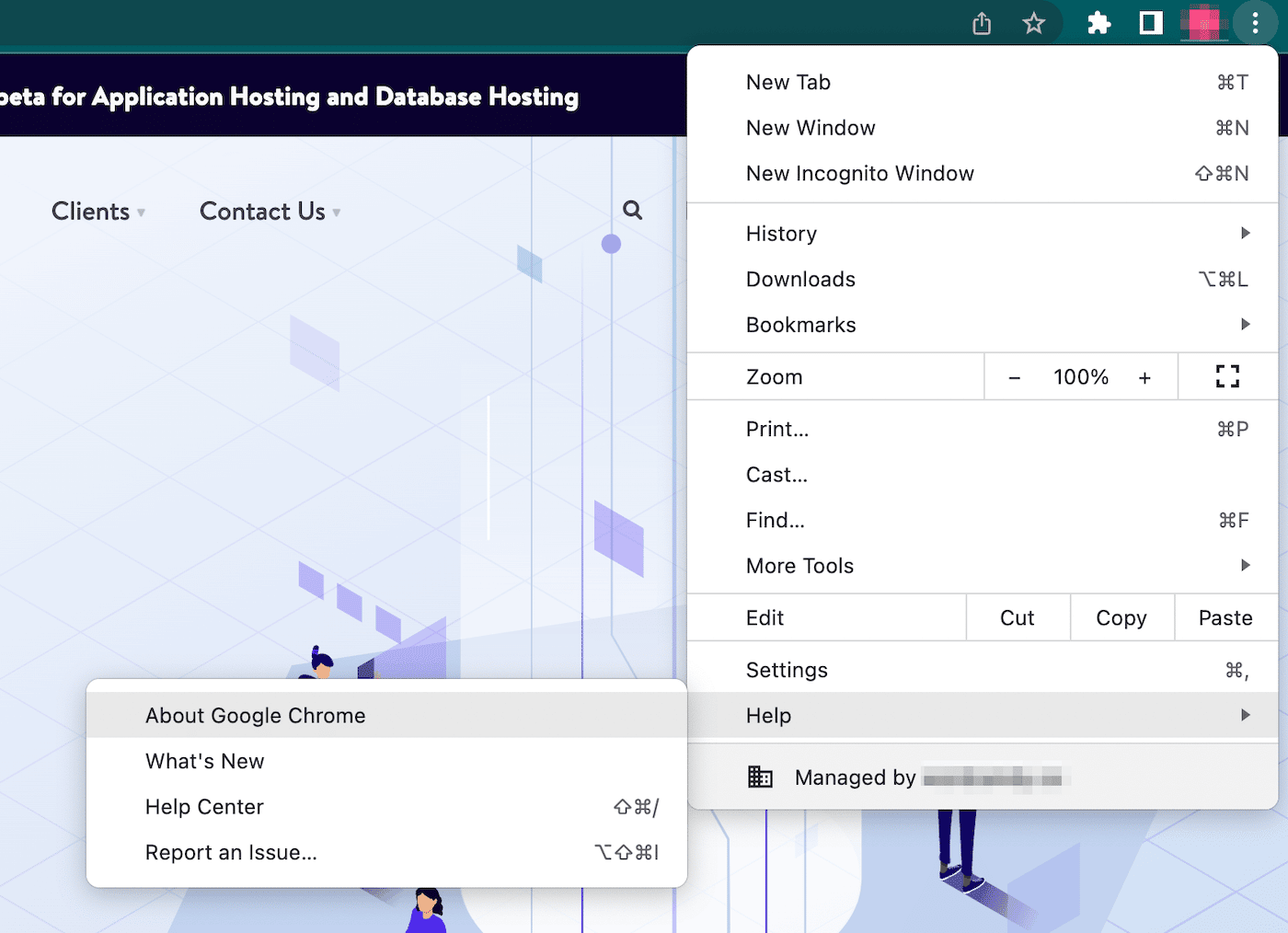
This will prompt Google Chrome to check for a new update. If there is one, it will automatically install it. To finish updating, you’ll need to relaunch the browser:
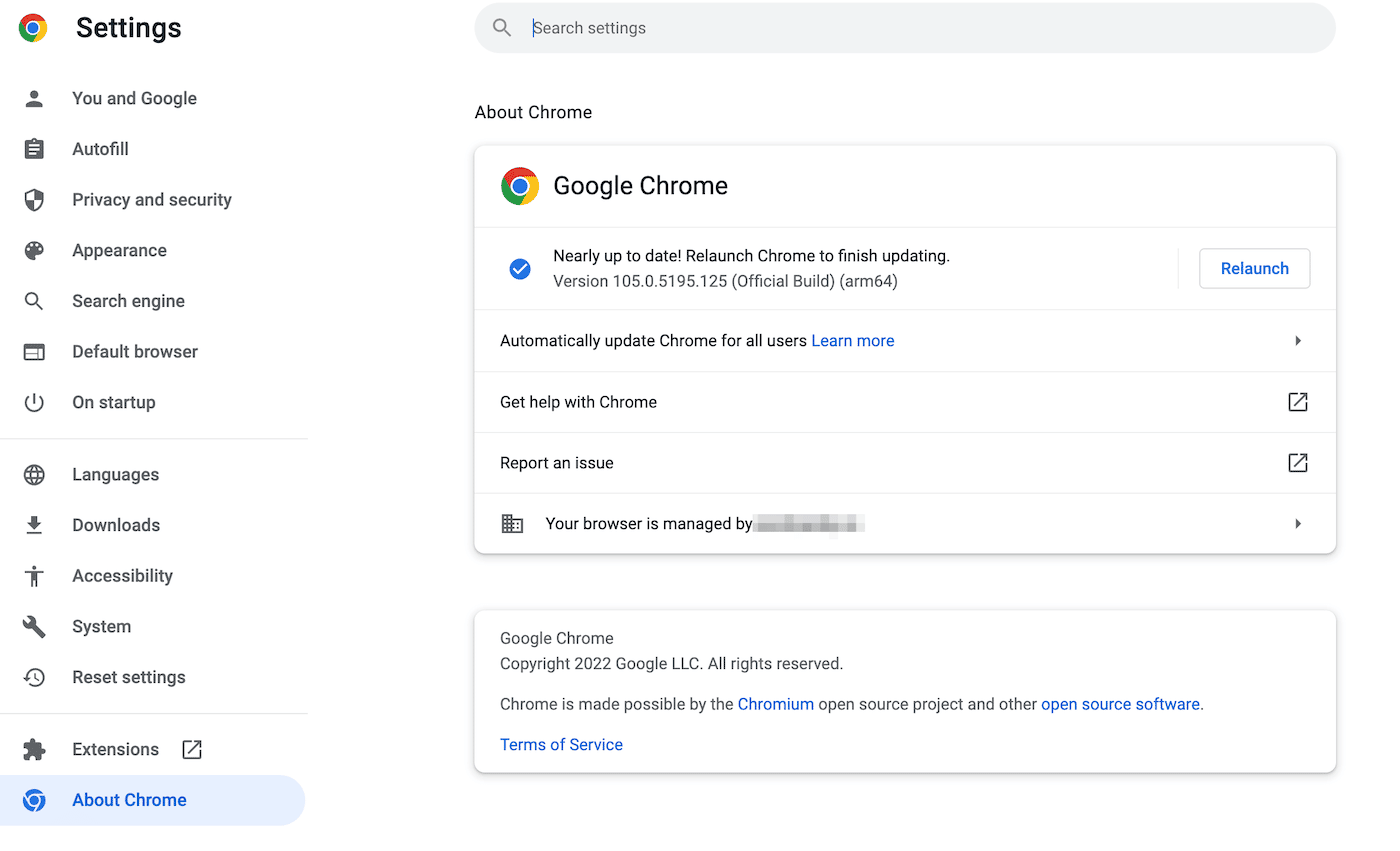
If you’re using the Google Chrome mobile app, you can simply open the App Store or Play Store, depending on your device type. Then, check for any app updates and install them!
2. Clear Your Browser Data
Whenever you experience issues during the rendering process, it’s a good idea to clear your browser data. By clearing your cache, cookies, and history, you can enable visited websites to authenticate your device and fulfill the request.
Depending on your browser, there are a few different ways to clear the cache. For Google Chrome, you can select More Tools > Clear Browsing Data:
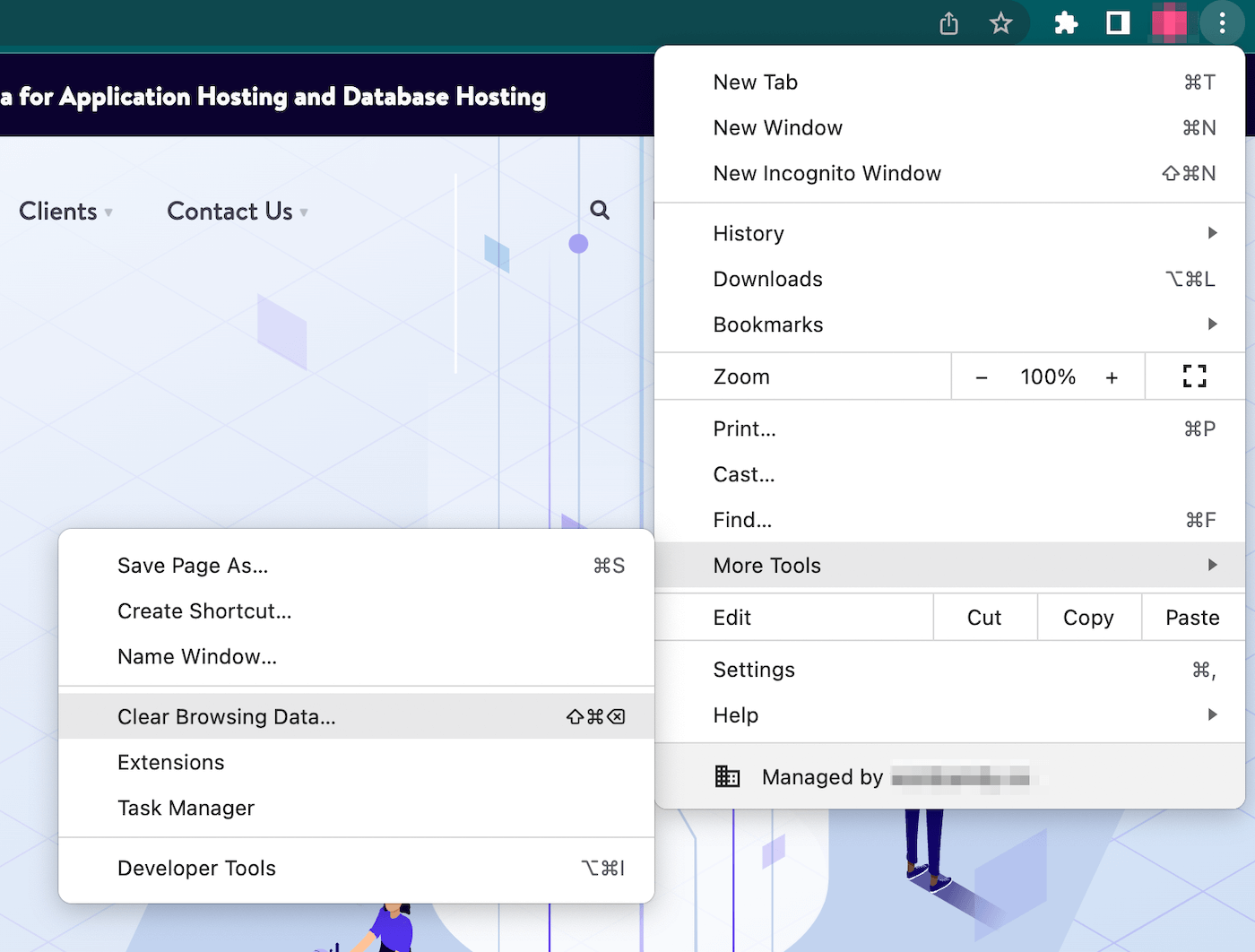
Using the pop-up window, you can specify the information you want to clear. You’ll want to be sure to select Cached images and files, but you can also get rid of your browsing history, cookies, and other data:
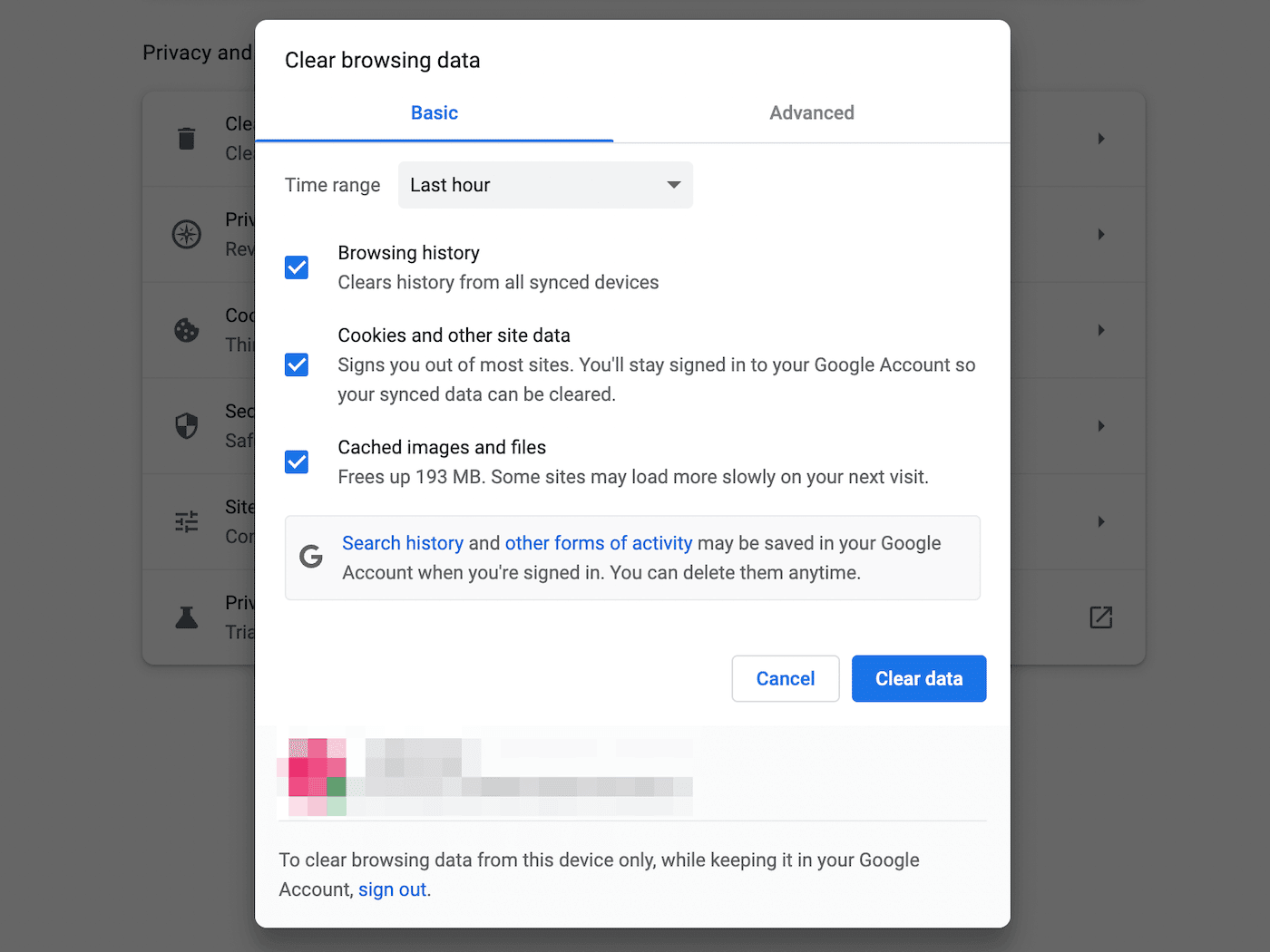
If you’re using Safari, it will be a similar process. To do this, go to Safari > Clear History:
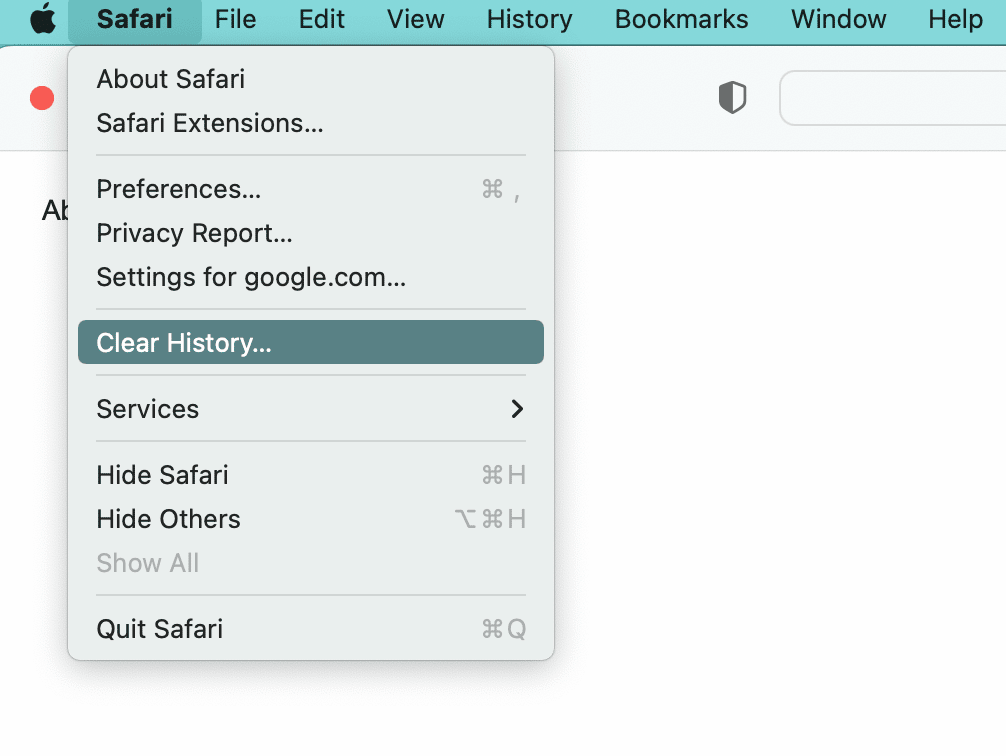
Then, you can choose to clear your cache, cookies, and site data from a specific time range. When you’re done, click on Clear History:
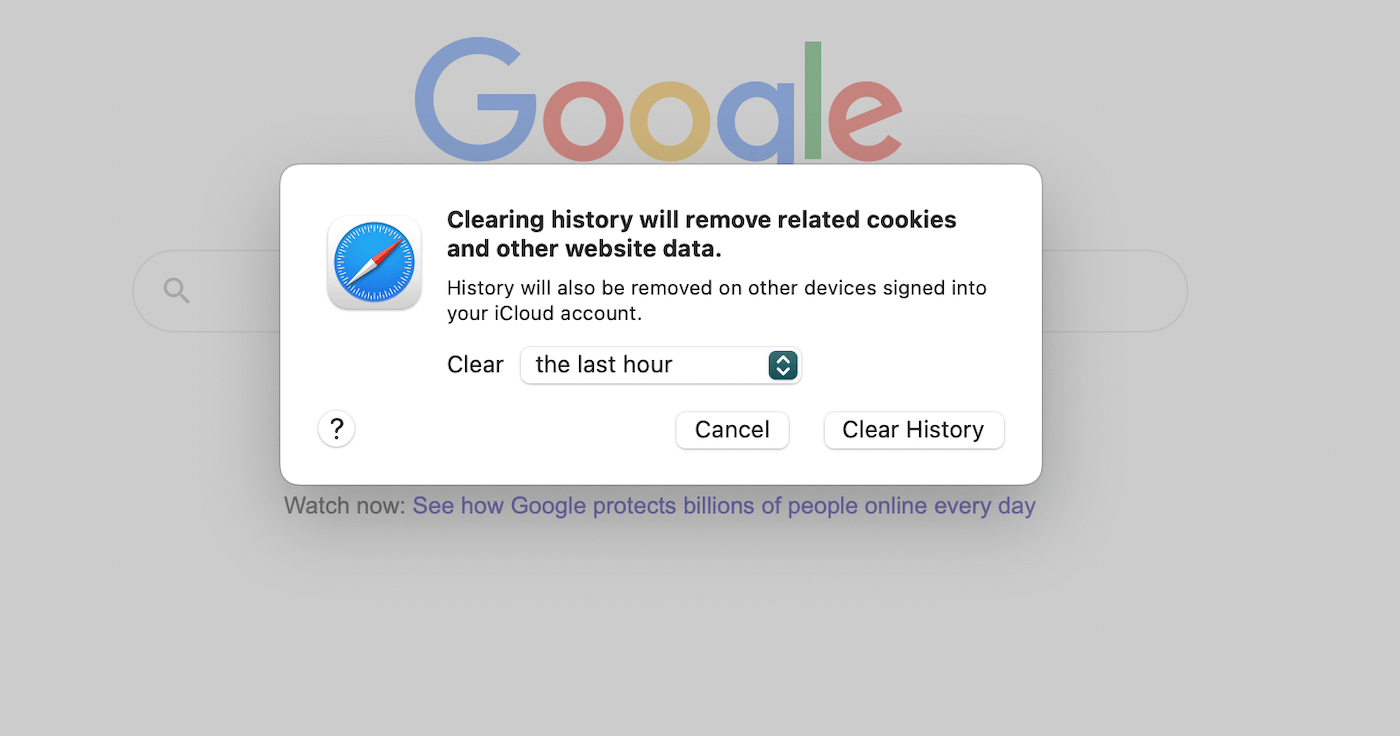
To clear your browser data on Mozilla Firefox, you’ll need to find the hamburger icon in the upper right-hand corner. Next, select History:

In the new tab, click on Clear recent history:
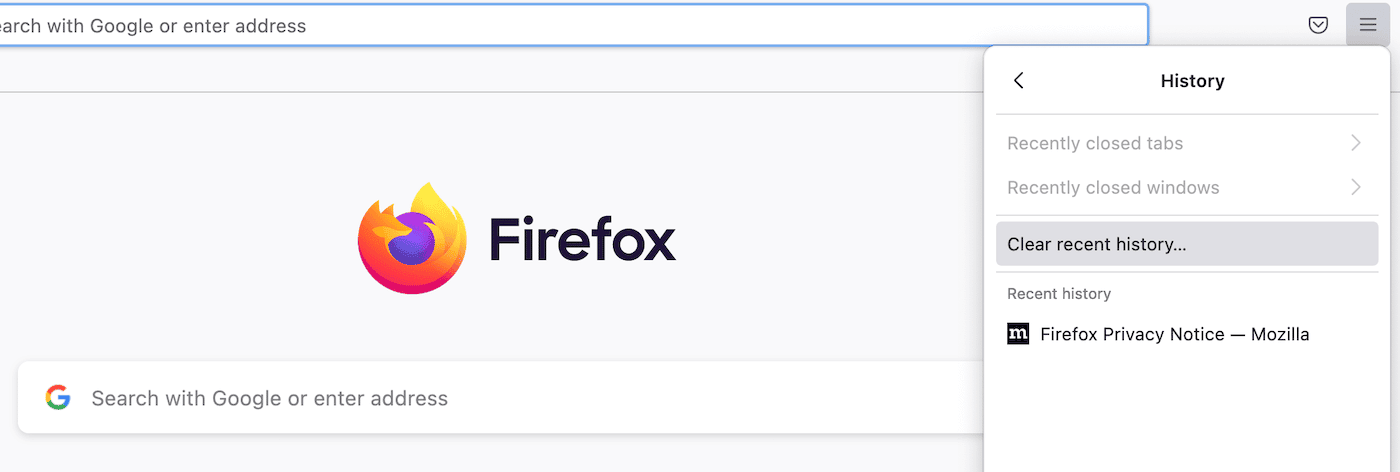
Like other browsers, you can choose only to clear certain data. However, it’s important to remember to select the Cache option:
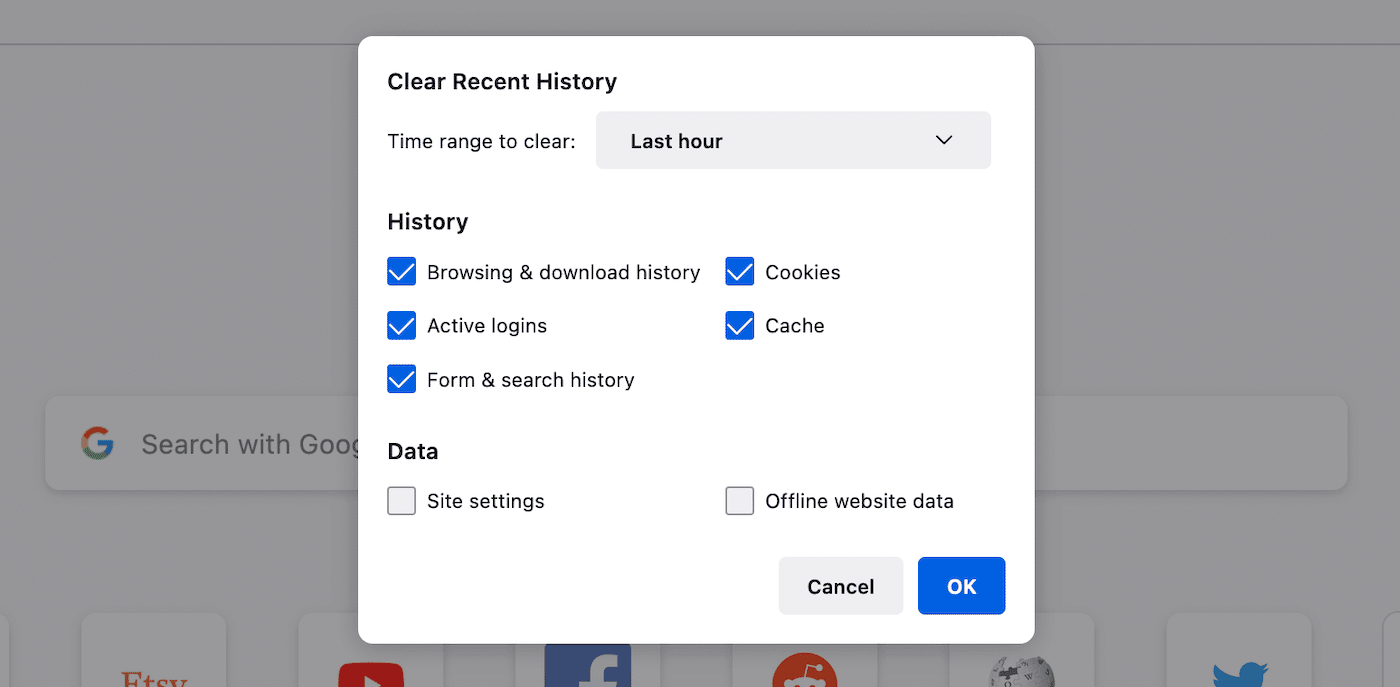
Now that you’ve cleared your browser cache try to visit the website where the error occurred. If you still see the err_http2_protocol_error message, you’ll need to try some alternative solutions.
3. Open a Private or Incognito Browser Window
Whenever you visit a new website, your browser will save information about that site in a cache. Once you visit the page again, your browser will pull the cached data rather than requesting the server all over again. Often, this can make the site load faster on repeat visits.
For this reason, you may want to avoid clearing your browser cache when trying to bypass the HTTP/2 protocol error. In this case, you can launch the browser in private or incognito mode.
This can be an effective one-time solution to avoid permanently deleting the cache or disabling third-party extensions. To do this in Google Chrome, extend the menu and click on New Incognito Window. This will open a private browser:

Using the incognito mode, try to visit the website again. It may enable you to do this without having to use more complicated solutions. However, keep in mind that this is primarily a short-term fix.
4. Disable or Uninstall Browser Extensions
As we mentioned earlier, third-party extensions could potentially interfere with how your browser and a web page interact. After you see the err_http2_protocol_error message, you can consider disabling these extensions to see if the error disappears.
To do this in Google Chrome, visit More Tools > Extensions:
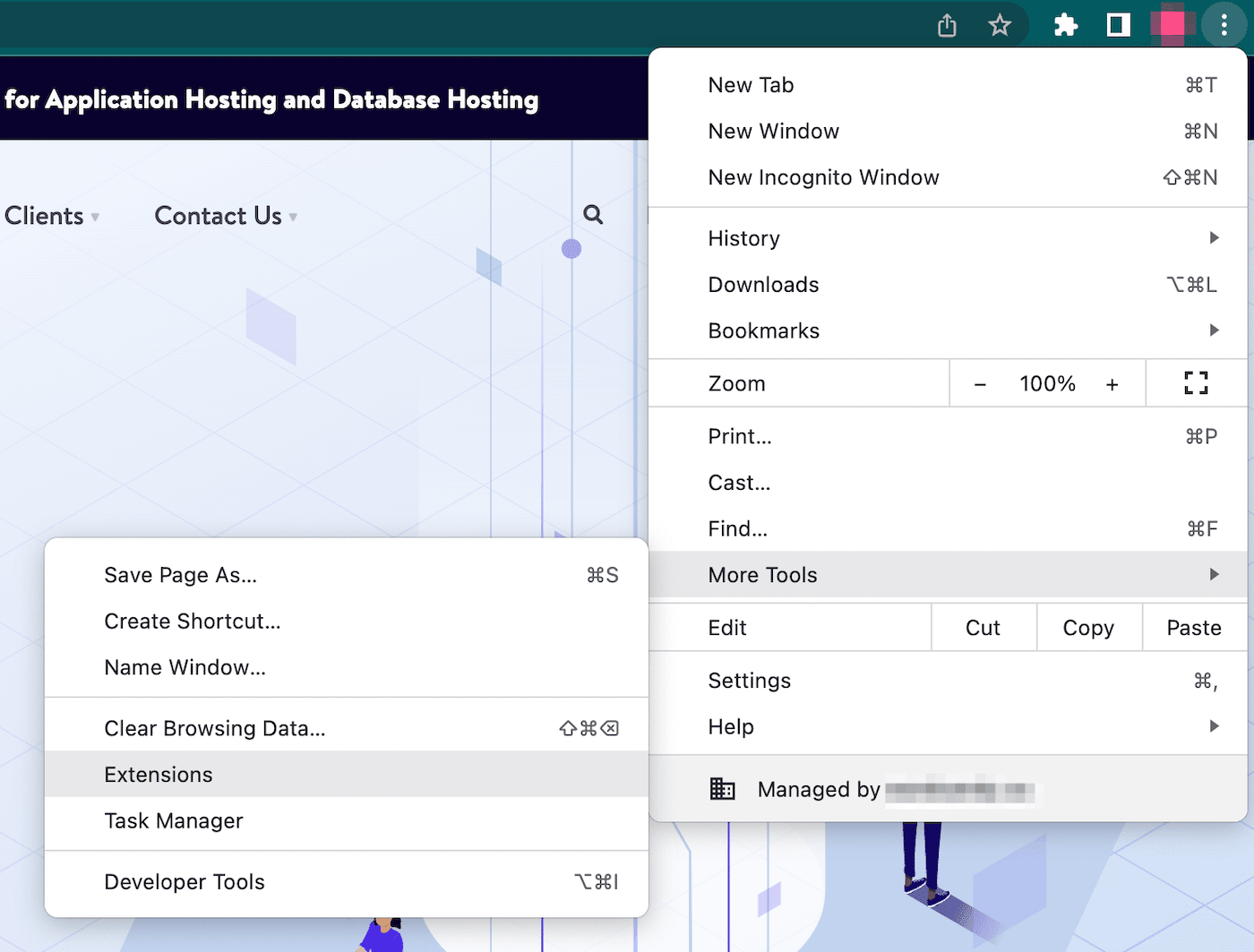
This will take you to a web page that lists your Chrome extensions. First, use the switches on the bottom-right corner to turn off each extension:

Now that your extensions are disabled try to go to the web page that caused the error. If the page loads, you’ll know that one of your extensions caused the problem.
Now, you can go back to the Extensions page and enable them one by one. After you turn on an extension, see if the error returns. When you find the problematic extension, consider removing it entirely.
5. Turn Off the Browser’s QUIC Protocol
Quick UDP Internet Connections (QUIC) is an encrypted transport network protocol that was developed by Google. Essentially, its goal was to increase the speed, security, and efficiency of HTTP traffic.
Currently, only eight percent of websites use QUIC. Therefore, when sites aren’t configured to process this kind of traffic, it can cause incompatibility between the client and server. As a result, this can display an HTTP/2 protocol error.
To solve this problem, you can turn off the QUIC protocol in your browser. In Chrome, you’ll simply need to enter the following URL into your search bar:
chrome://flags/#enable-quic
Now you’ll see a highlighted result labeled Experimental QUIC protocol. For this setting, change it to Disabled:
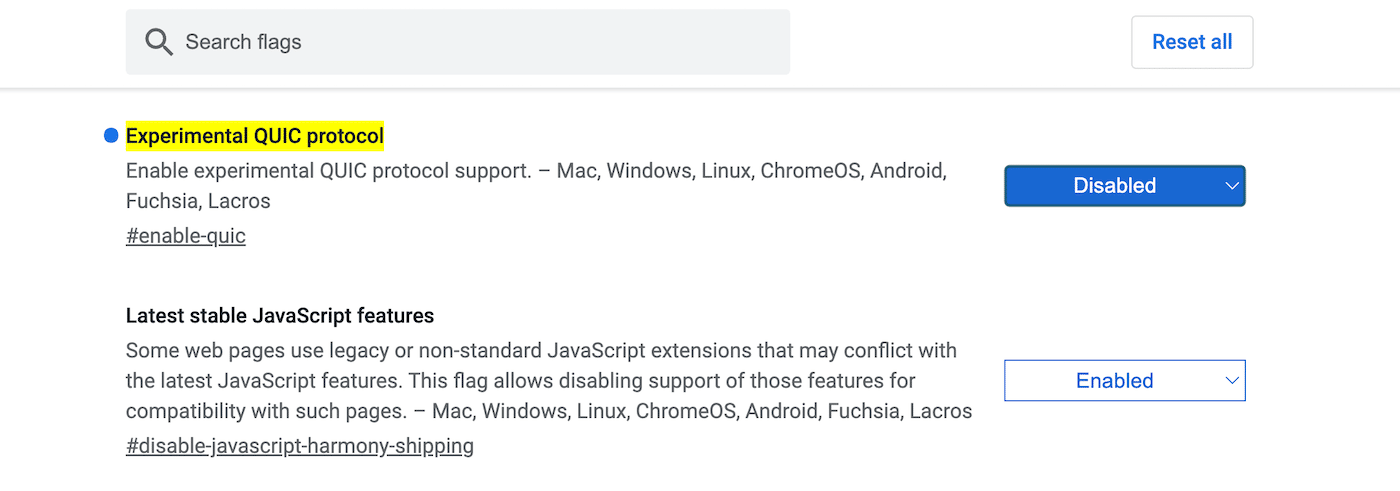
Once you make this change, you’ll need to relaunch your browser. This will disable QUIC, allowing you to view the incompatible website.
6. Restore the Browser’s Default Settings
As you use Google Chrome, you may not notice small glitches that can change its default settings. Over time, this can lead to more errors like the err_http2_protocol_error.
Fortunately, you can get your browser back to normal by reverting its settings to the default options. To get started, open the Google Chrome Settings page:

On the left, find the Reset settings tab. Then, select the Restore settings to their original defaults option:
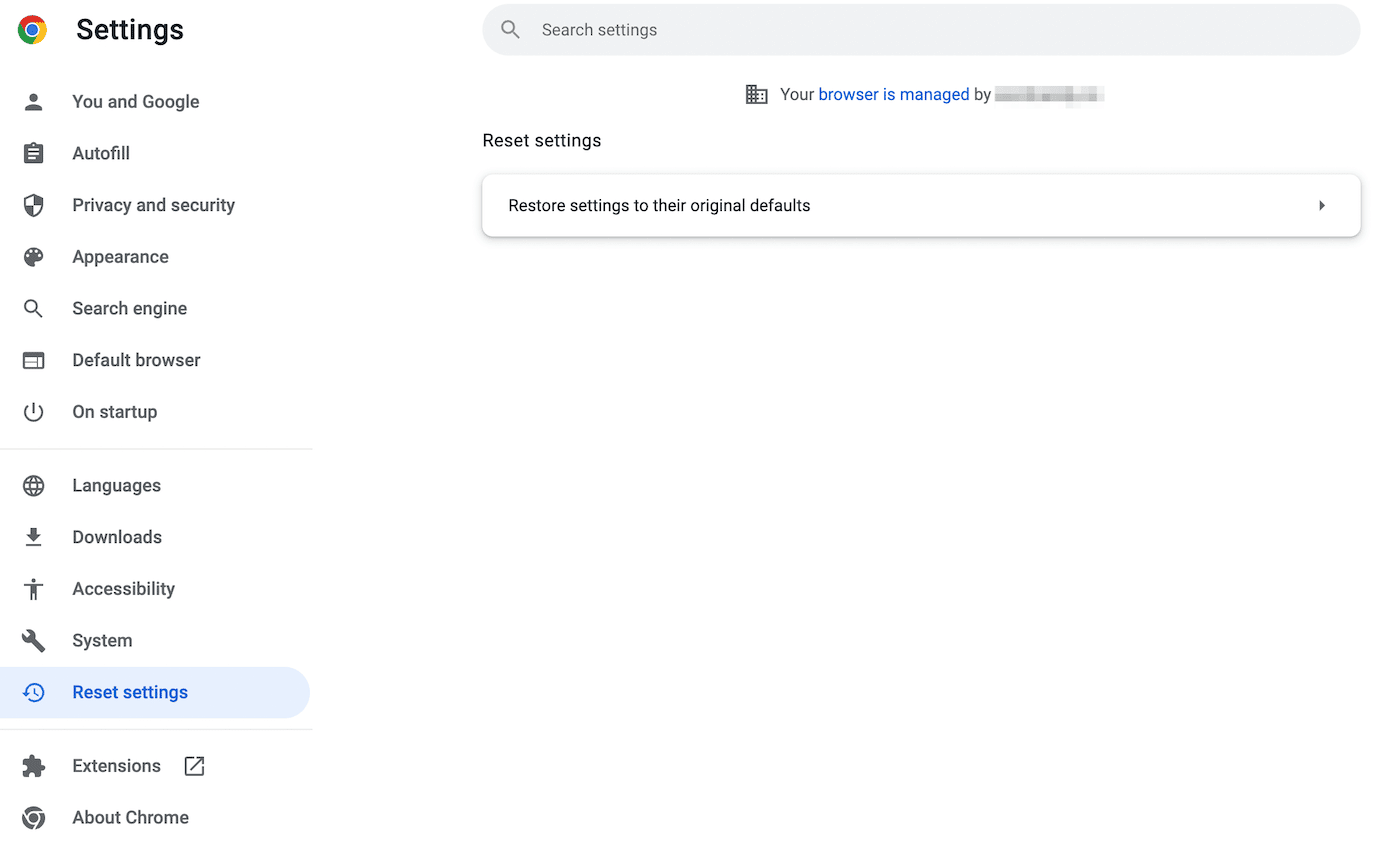
Finally, you’ll just need to confirm that you want to erase your current Chrome settings. If you do, click on Reset settings:
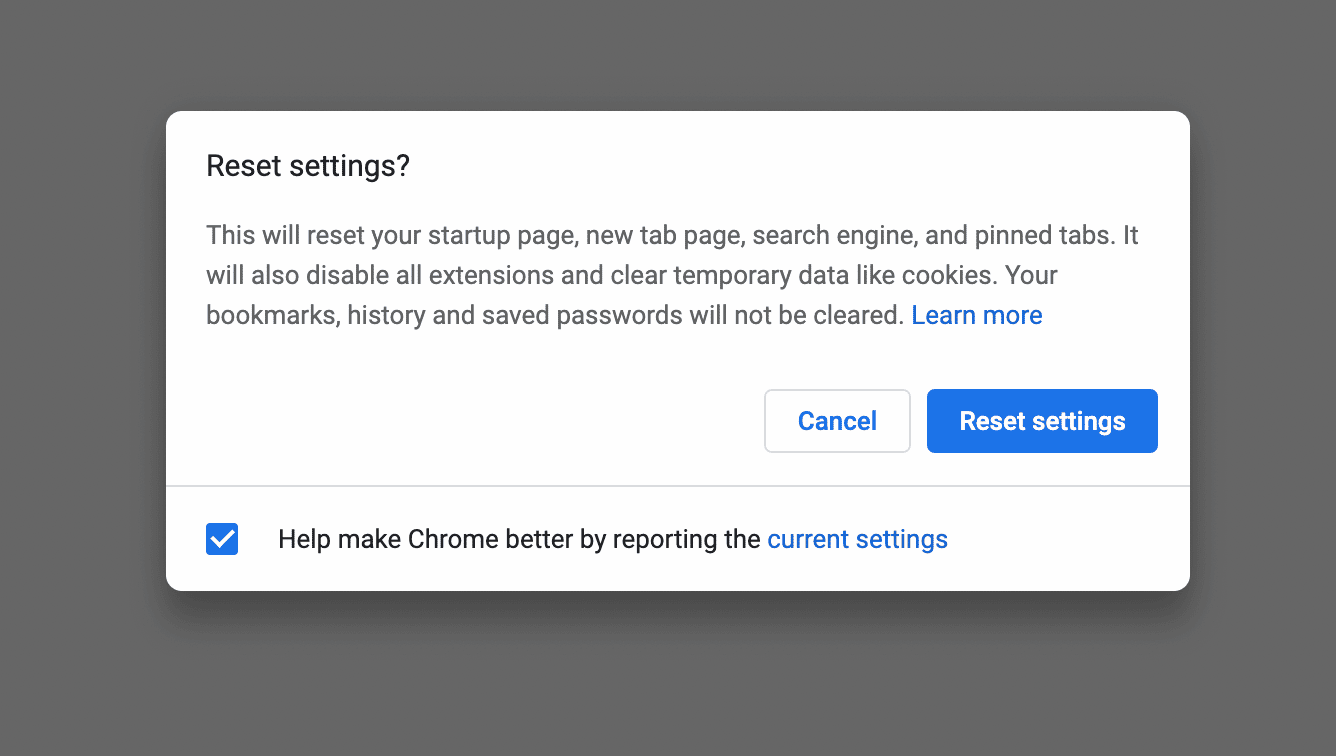
It’s important to keep in mind that this will erase your current search engine history, startup page, pinned tabs, extensions, bookmarks, and more. It will essentially revert your browser to a clean slate. However, it can remove any conflicting software or settings that are causing the HTTP/2 protocol error.
You can also consider resetting the experimental settings in your browser. These are not fully tested, functional features, so they could prevent your browser from communicating properly with a website.
To find your advanced experimental settings, search for the following address:
chrome://flags/
In the upper right-hand corner, select the Reset All option. If certain features were accidentally enabled, this will revert them to the default settings:
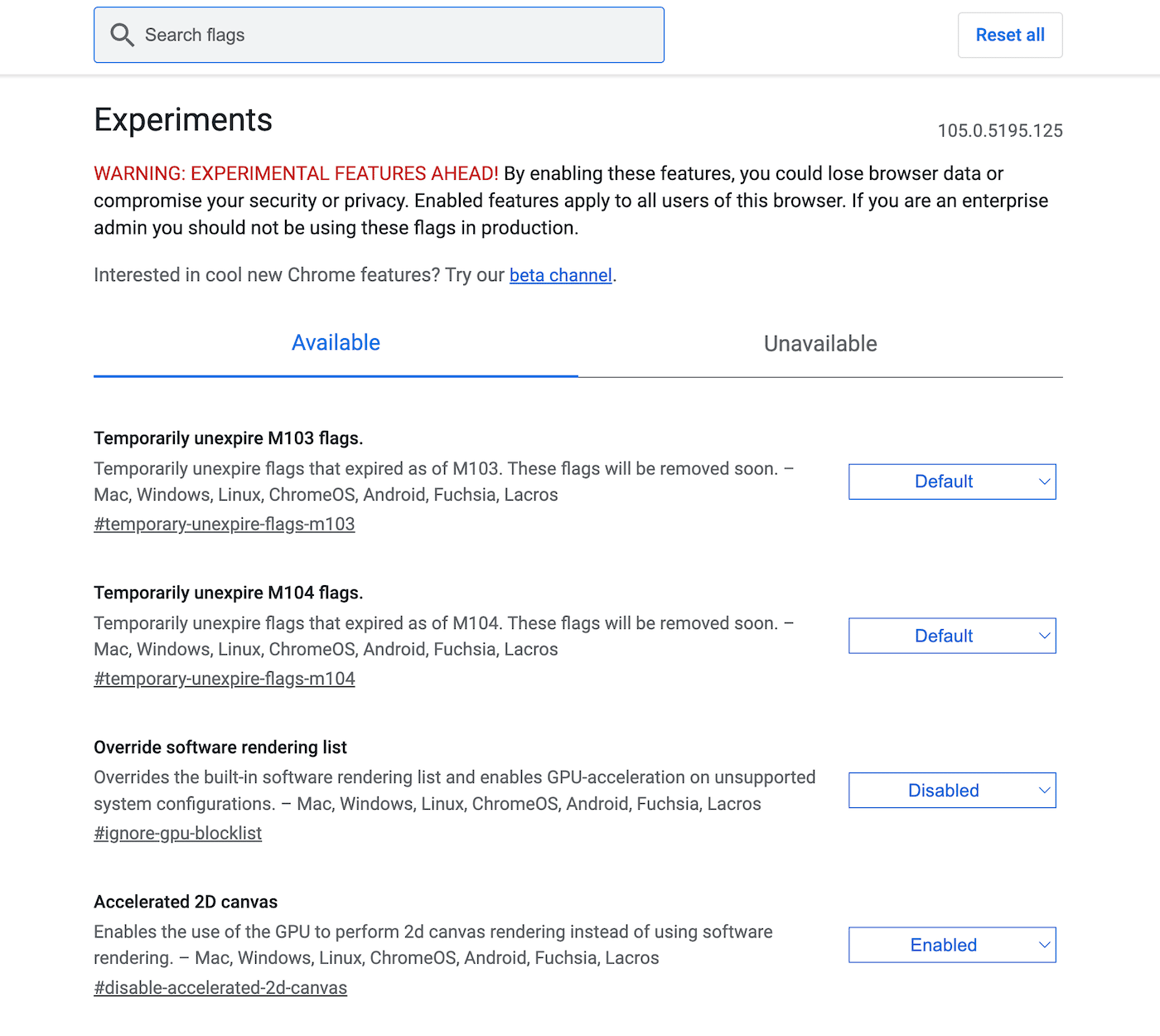
Then, these changes will be applied whenever you relaunch Chrome!
7. Reinstall Google Chrome
After executing all these methods, you may still see the troublesome HTTP/2 protocol error. If so, there could be an error within the Google Chrome app. Even if you restored the default settings, you may want to consider reinstalling the entire browser.
First, you’ll need to delete the browser from your device. To do this with a macOS operating system, open the Applications folder and move the Google Chrome app to the trash:
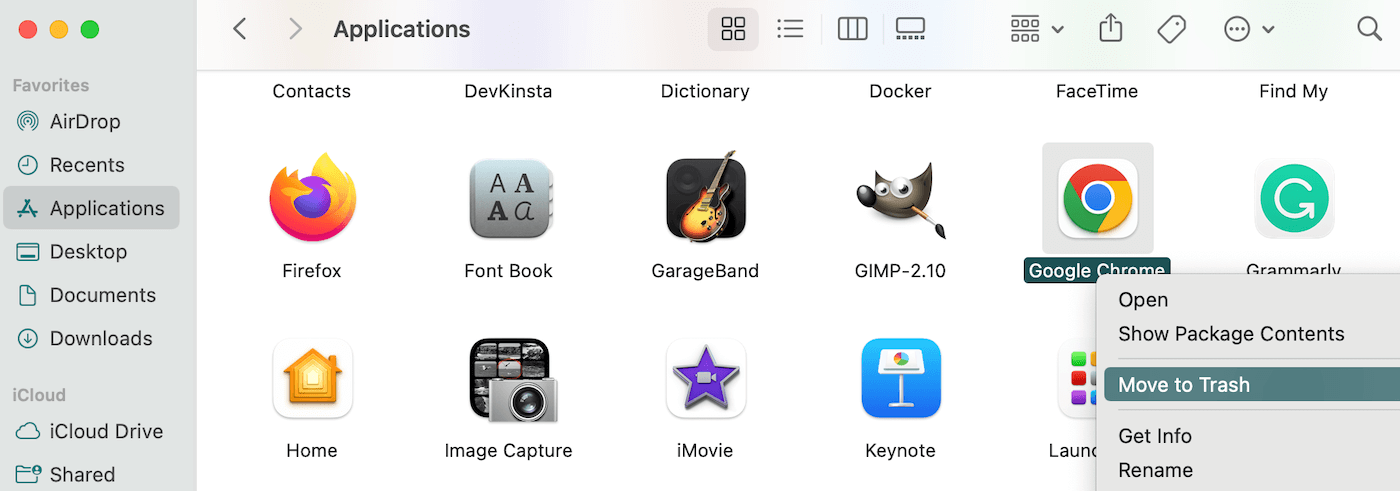
You’ll also want to delete any Chrome software updates. To find them, search for ‘~/Library/Google’ on your device. In your results, delete the “GoogleSoftwareUpdate” folder:
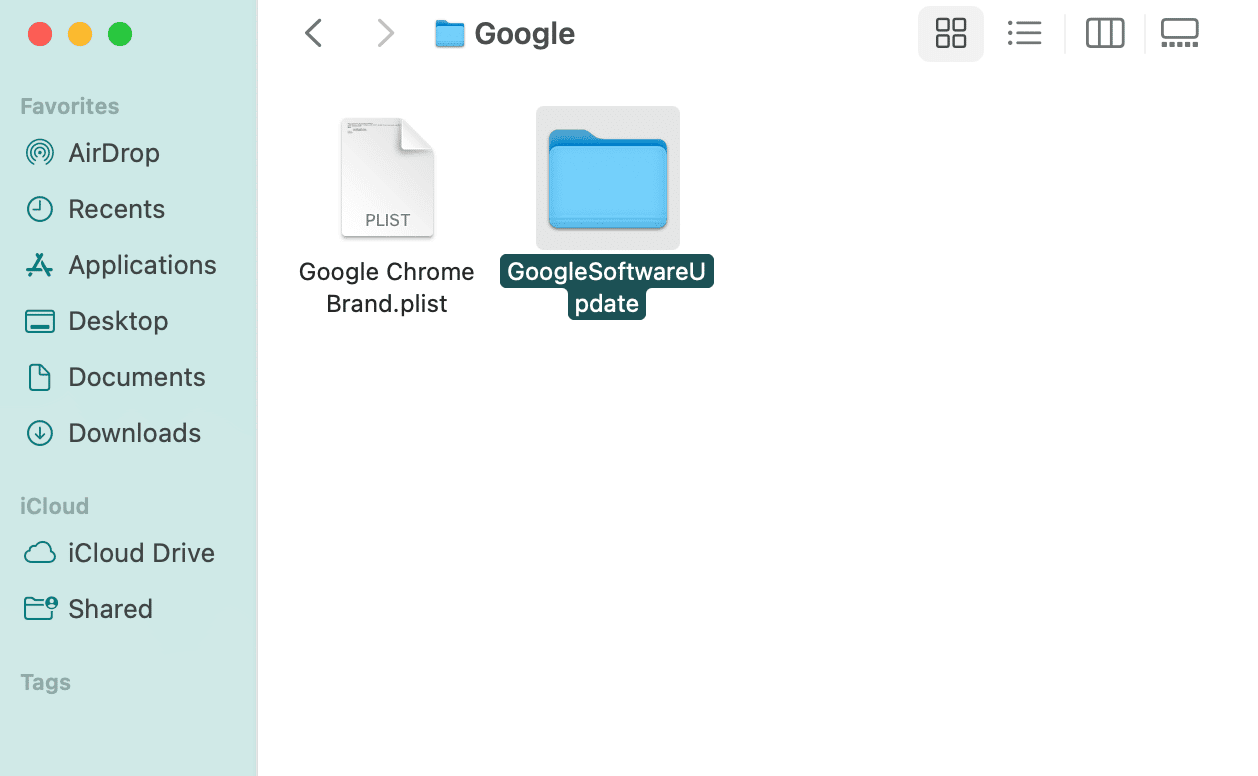
If you’re a Windows user, you’ll use different steps to delete Chrome. To start, click on the Windows Start button and search for the Control Panel. Open it, then find the Programs option. Click on Uninstall a Program under Programs:

Now you’ll need to find Google Chrome and right-click on it. Lastly, hit Uninstall:

For both Mac and Windows users, you can reinstall Chrome in the same way. You’ll simply need to download the file included on the Google Chrome website:
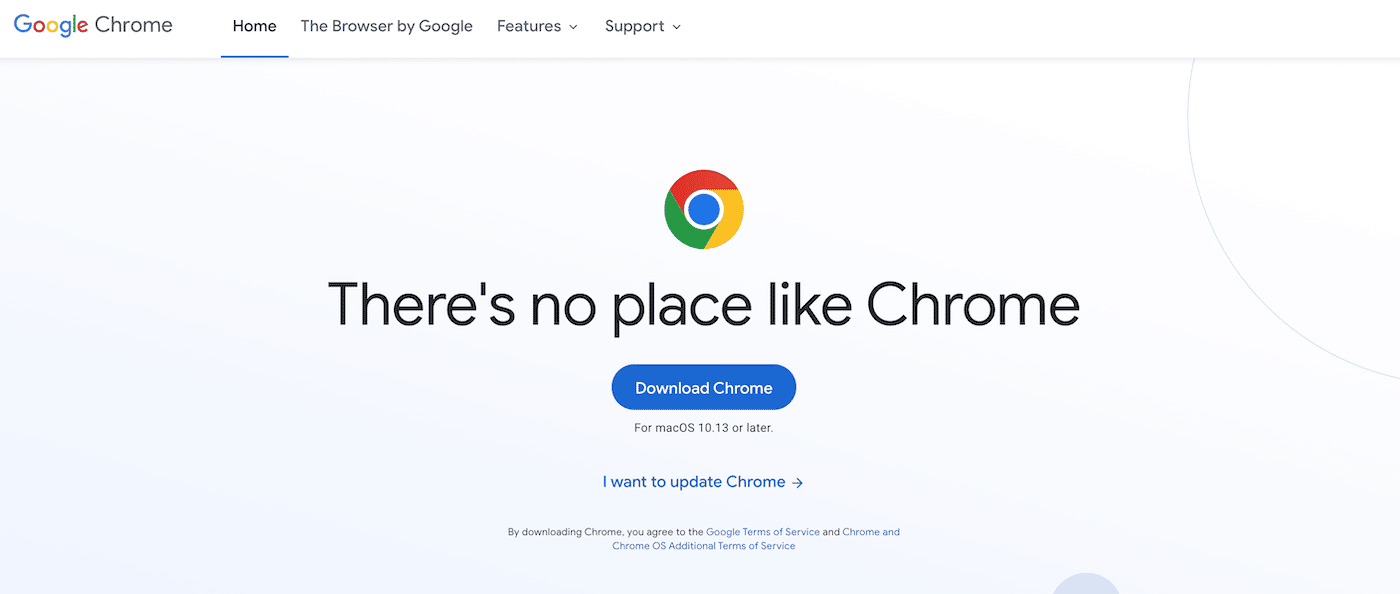
Although this method could potentially solve the err_http2_protocol_error, it’s best only to use it as a last resort. Deleting Chrome will also remove all of its data, so be sure to try a few simpler solutions beforehand.
How To Fix the err_http2_protocol_error In a Device
So far, we’ve examined some methods to fix the err_http2_protocol_error using a web browser. However, in some cases, the browser may not be the source of the problem. To help you troubleshoot the issue, let’s discuss how to make your device compatible with the HTTP/2 protocol.
1. Reset Your Device’s Date and Time
Although it may not seem like a big deal, it’s important to have the correct date and time displayed on your device. If this information isn’t accurate, the incorrectly time-stamped data packets could be refused. This can lead to an err_http2_protocol_error.
With a Windows operating system, you can right-click on the clock in the bottom-right corner of your desktop. Then, select Adjust date and time:
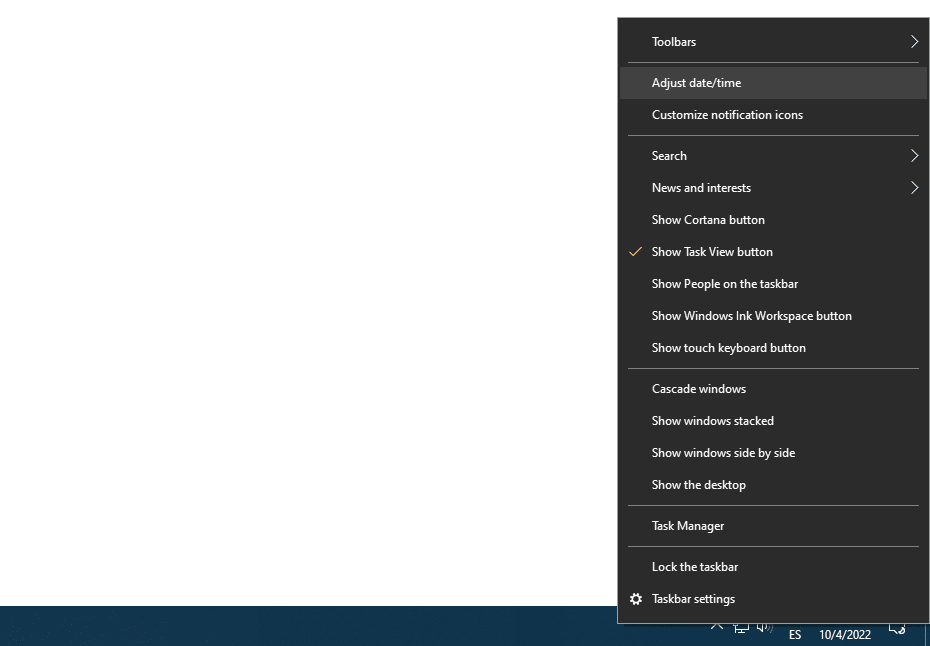
If your computer isn’t automatically displaying the right time, you’ll need to disable the Set time automatically setting. Beneath this, be sure to set the correct time zone:

Next, select the Change button to Set the date and time manually. In the pop-up window, enter the correct date and time:
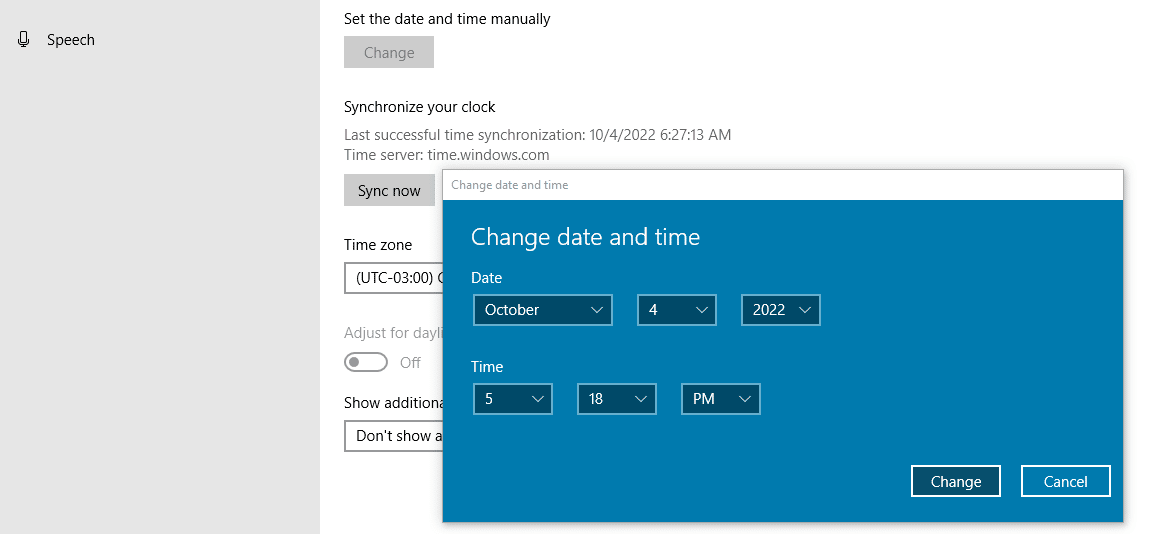
For Mac users, click on the Apple menu. Then, select System Preferences. Here, find the Date & Time option:
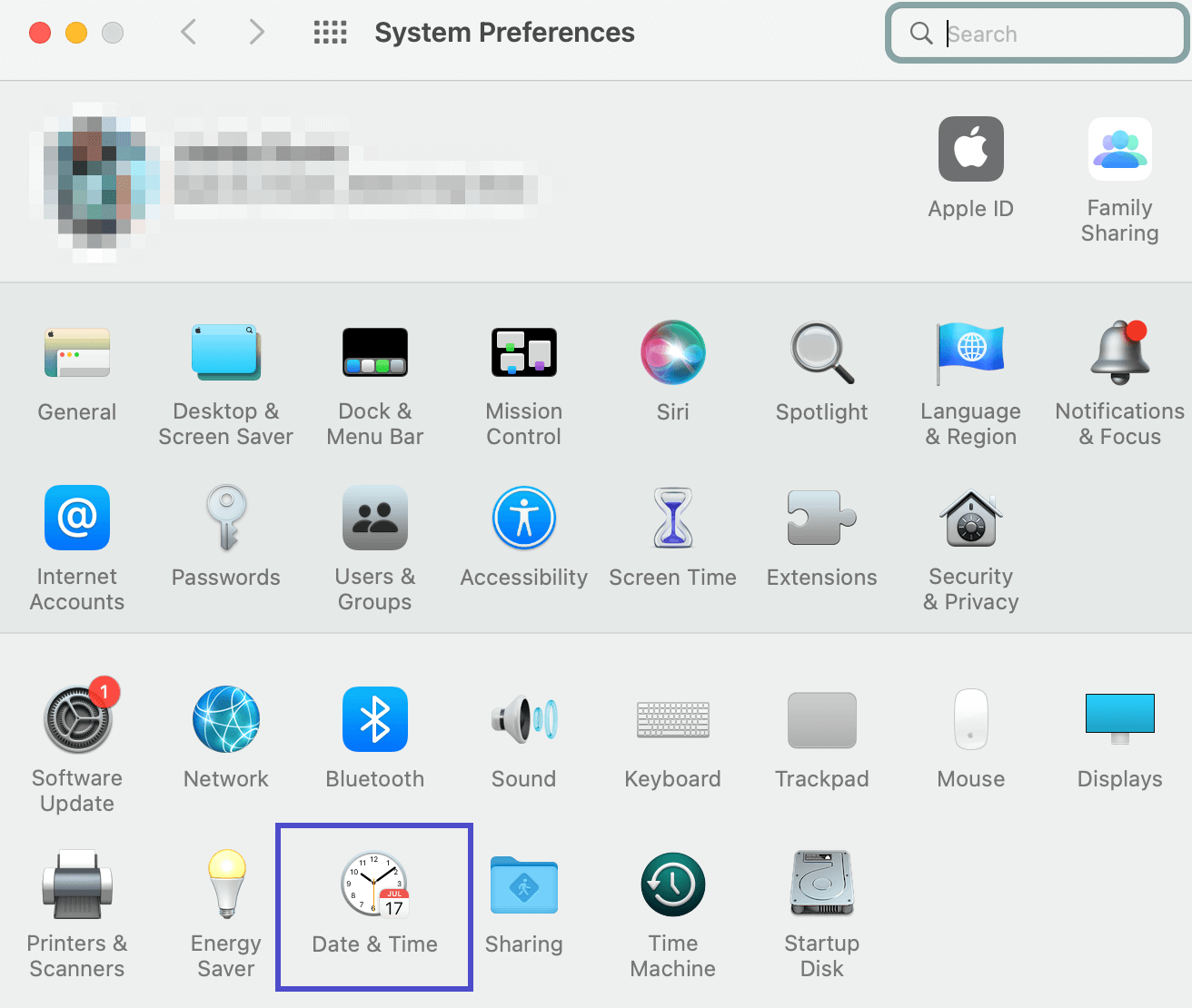
In the bottom-left corner, click on the lock to make changes. Now you can deselect the Set date and time automatically option and choose the correct values:
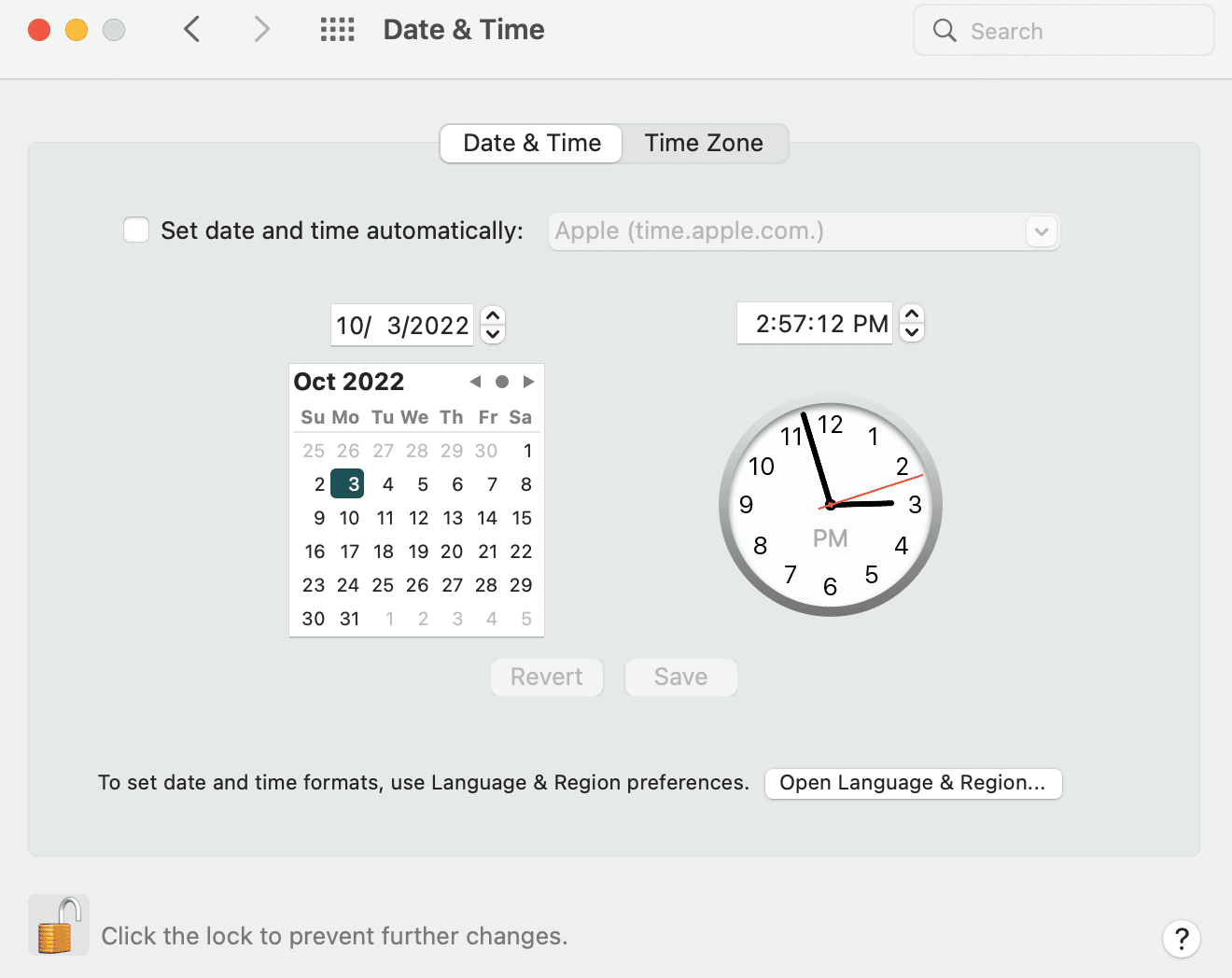
After you make these changes, try relaunching the web page!
2. Update Your Operating System
If you haven’t updated your device in a while, this can cause a multitude of performance issues. To ensure you can avoid any conflicts between your operating system and visited websites, you’ll need to check for recent upgrades.
Using a macOS device, you can start by performing a backup. Then, go to System Preferences > Software Update:
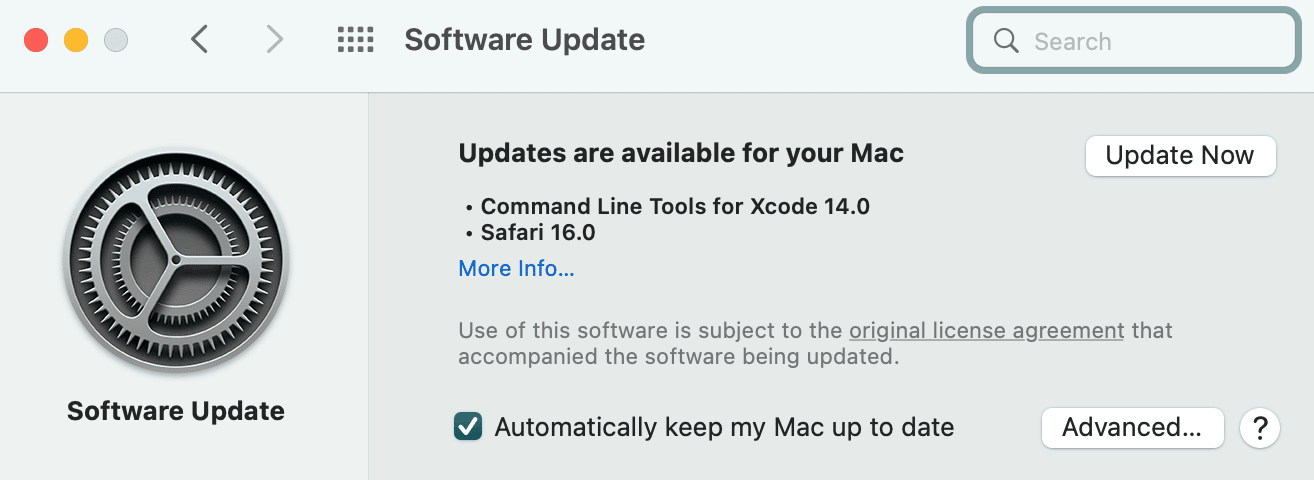
In this window, you’ll see any newly available updates. If you’re ready to install them, click on Update Now.
With a Windows computer, you can navigate to Start > Settings > Windows Update. If you haven’t already, install the latest update:

Once your device is up-to-date, it should be compatible with most websites that you want to visit. To see if this is the case, check whether the HTTP/2 protocol error is fixed. If not, continue with the following methods.
3. Flush the DNS
On the internet, the Domain Name System (DNS) functions as an index for all available websites and their unique IP addresses. When you visit a website, your operating system or browser will save this information in a database. This can lead to faster loading times on revisited websites.
If you’re seeing the err_http2_protocol_error, you can try flushing your DNS cache. Put simply, this will erase the IP addresses and other DNS data from your computer.
To flush a Mac DNS cache, open the command line interface called Terminal. In this window, enter the following command:
sudo killall -HUP mDNSResponder
This should successfully clear the DNS, removing the HTTP/2 protocol error. However, keep in mind that you’ll need to use slightly different processes for older versions of macOS.
If you have Windows 10, 8, 7, or XP, you can start by opening Command Prompt. In the command line, paste this command:
ipconfig /flushdns
You should see a confirmation message once the DNS has been flushed!
4. Check Antivirus Software
To keep your computer safe while you’re browsing, you likely have an antivirus program installed. Although this software offers many security benefits, it can occasionally flag certain applications as malicious. When this happens, it may unnecessarily limit your access to a website.
If none of the previous methods worked, you can check your antivirus software to see if it is functioning properly. First, open your notifications, which can display new security issues:
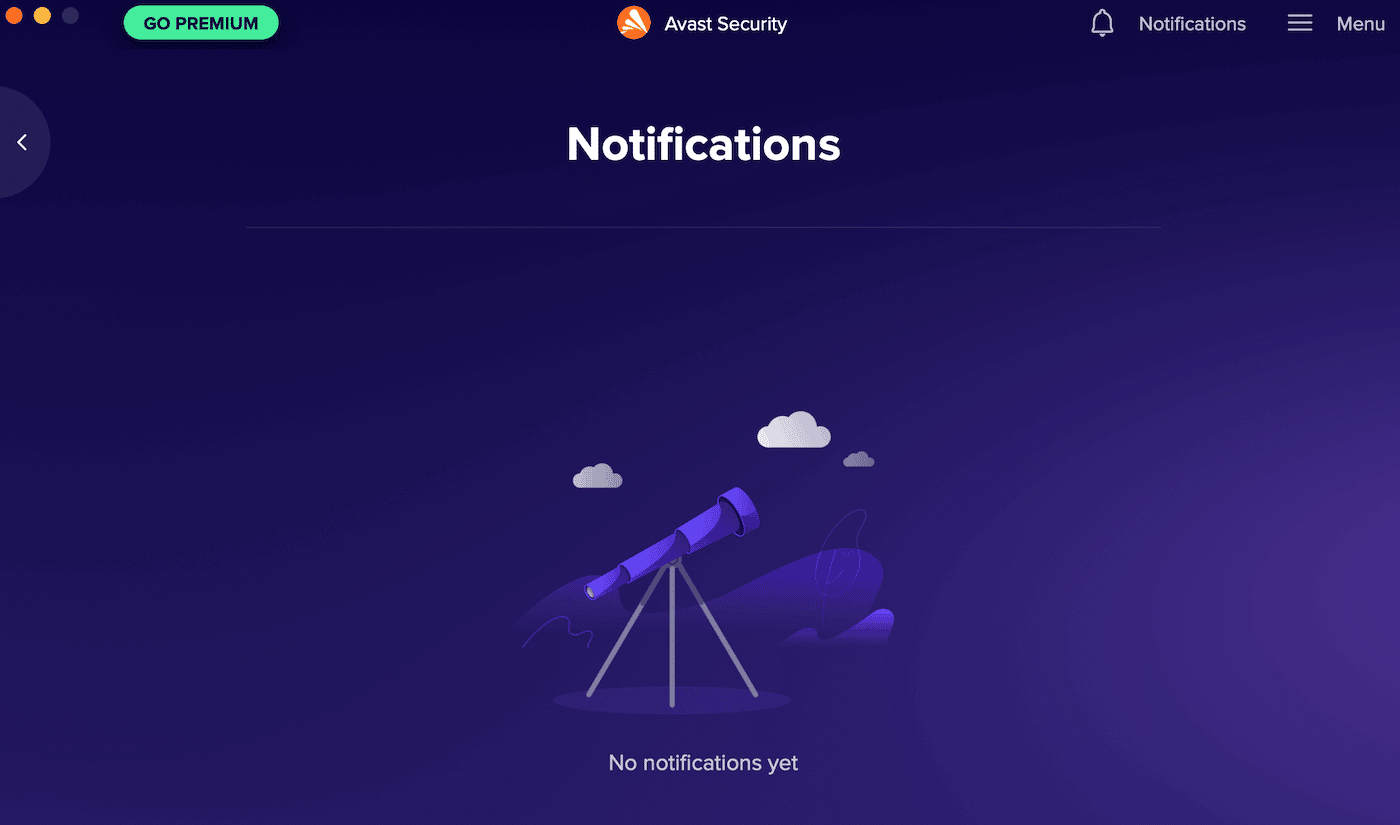
Most antivirus software will also have a quarantine list. This will contain all of the detected security threats on your computer:
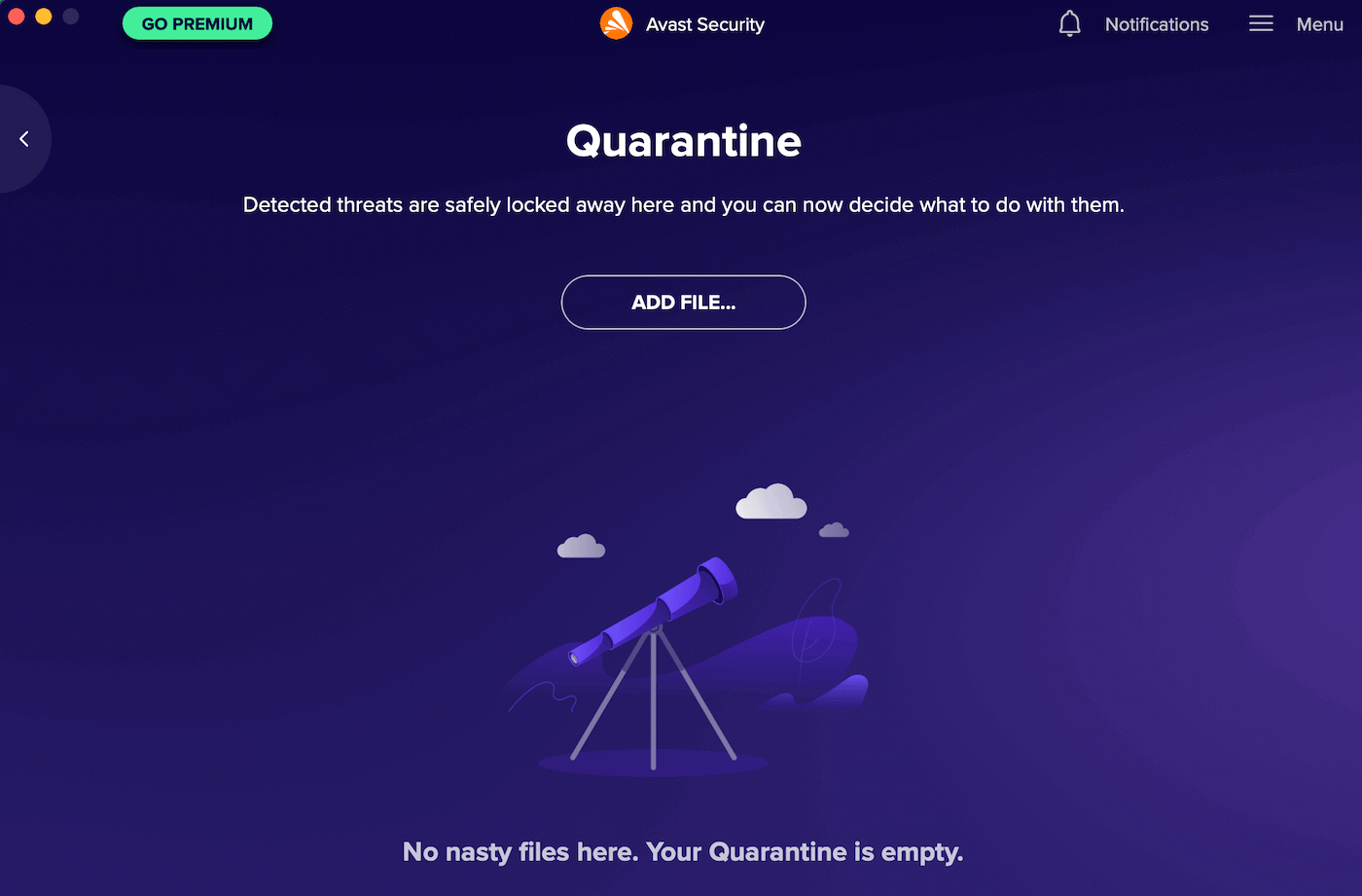
In either of these areas, evaluate whether any unwanted applications are being flagged. If so, you may need to temporarily disable your antivirus software.
Summary
When the err_http2_protocol_error happens, it can be extremely frustrating. Instead of quickly viewing necessary online resources, you’ll only be able to see an error message. Luckily, you can take a few simple steps to solve this problem.
Even as a complete beginner, you can optimize your web browser to bypass HTTP/2 protocol errors. By simply clearing the cache, opening a private window, or turning off third-party extensions, you can successfully view the blocked content. If the problem lies in your operating system, you can consider performing software updates or flushing the DNS cache instead.
As a website owner, you’ll need to know that your web pages can be reached at any time. With Kinsta, you’re able to use our HTTP Status and Redirect Checker to make sure your website is functioning correctly. Additionally, you can check your disk usage in the MyKinsta dashboard!

